In today’s ultra-connected world, one that moves at a break-neck pace, email has become the preferred medium of communication for many professionals.
If you think about it, it kind of makes sense: For one thing, emails don’t take up any physical space, yet, at the same time, you never have to worry about losing a particular email.
Additionally, emails aren’t intrusive; they don’t interrupt your workflow.
And, once you receive an email, you can respond whenever is convenient for you.
Over and above, emails allow you to attach other documents and files to them, making it possible to relay more than just important information.

19 alternative ways to say “please see attached”
Almost anyone who has worked in a professional setting has had to send an email with an attachment at one point or another (that’s if you don’t send email attachments every other hour).
However, when you do send an email attachment, what do you write in the main body of your email?
Do you say “please see attached”?
Or, do you prefer the more formal “kindly find attached”?
Back in the olden days, before we had email and when we had to send each other physical letters instead, people tended to write “Enclosed please find my (file/ document/ take your pick)” anytime they sent a document or other file with their letter.
This might seem stilted to you, but everybody used the word “enclosed” because this was what they were taught in high school.
Alternatively, most people today will opt for “please see attached” or “please find attached” given their simplicity and directness.
Yet, both these options can still come across as a bit stuffy and redundant. This is not to mention that, in different contexts, you might want to use different phrases.
So, let’s take a look at alternative ways of saying “Please see attached.”
You can use the following phrases when emailing a friend or close colleague; the phrases are informal.
1. Here is …
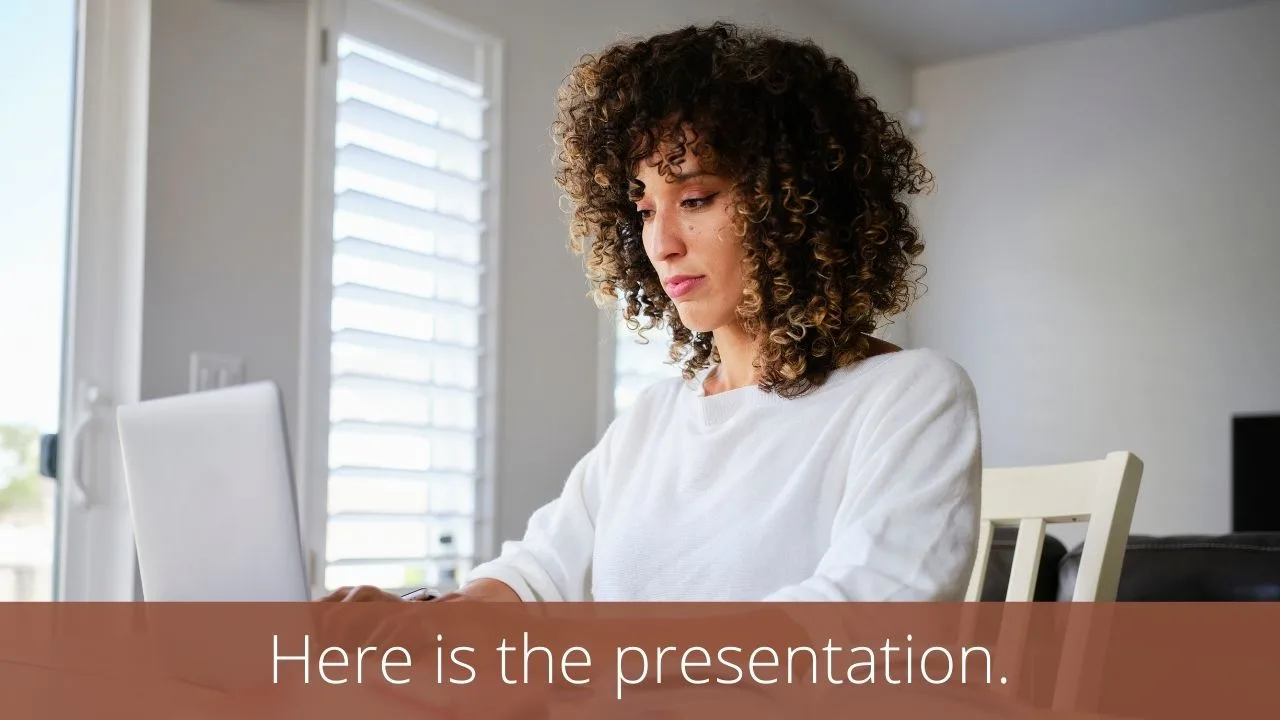
When being informal, you don’t have to worry about highfalutin language or even using the word please; instead, you can be direct and to the point. Using “Here is …” is a perfect case in point.
However, this phrase is best used when the main reason you are sending the email is to send the attachment. In other words, the entire email body can be made up of this phrase and only this phrase.
Example:
Let’s say your friend at work asked you to send them the presentation you were doing tomorrow together. You could attach the presentation to an email, and the email will read as follows:
It’s that simple.
2. Take a look at the attached …
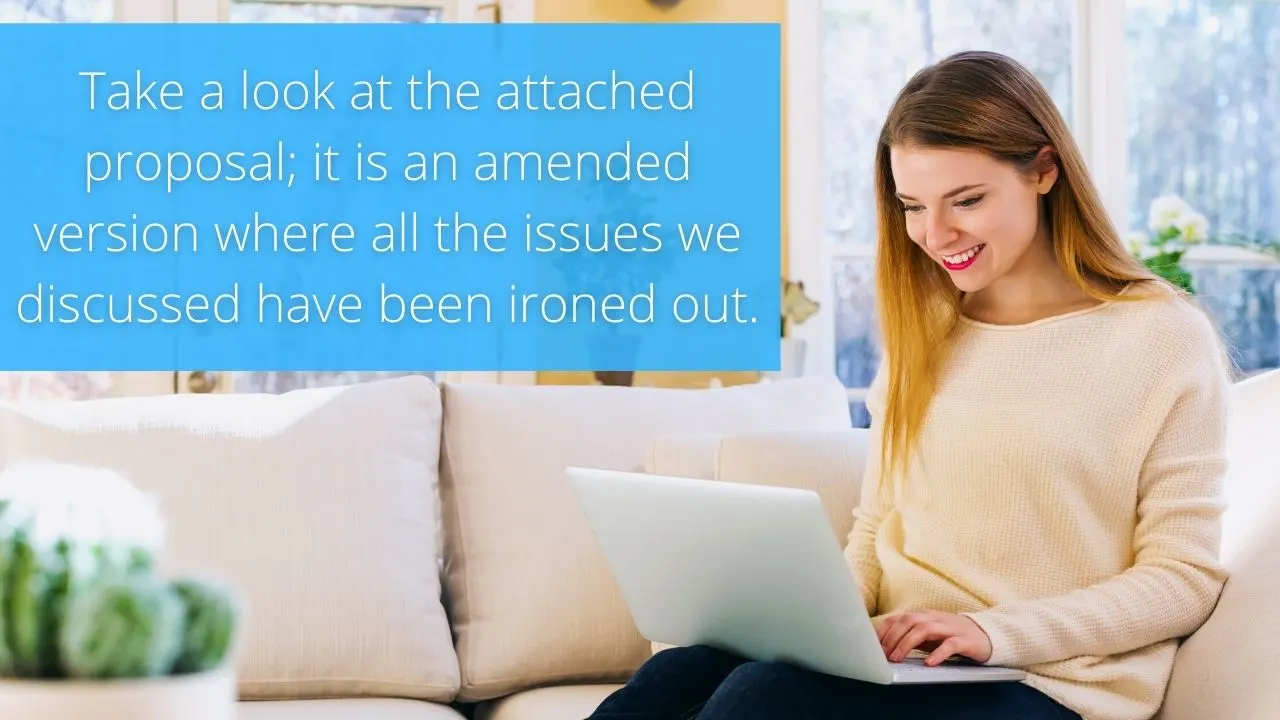
Whenever you’re out with a friend and you want to show them something, do you tell them “please check this out” or do you just go for the direct “check this out”?
Unless you’re friends with the most proper people on the planet (in which case, why?), you probably just say “check this out.” And, when you do say that, you are, more often than not, waiting for a response of sorts.
The same thing applies to “take a look at the attached (file/ document/ anything else).”
You can use it with friends, and it signals that you are expecting their feedback in some way.
Interestingly, “take a look at the attached …” can be made more formal if you add a please at the beginning, giving you “please take a look at the attached …”
Example:
Let’s say that you wanted your colleague’s input on your latest draft of a business proposal. This is an email you could send them.
Yesterday, we went over some of the problems with the business proposal.
Take a look at the attached proposal; it is an amended version where all the issues we discussed have been ironed out.”
3. Don’t say anything
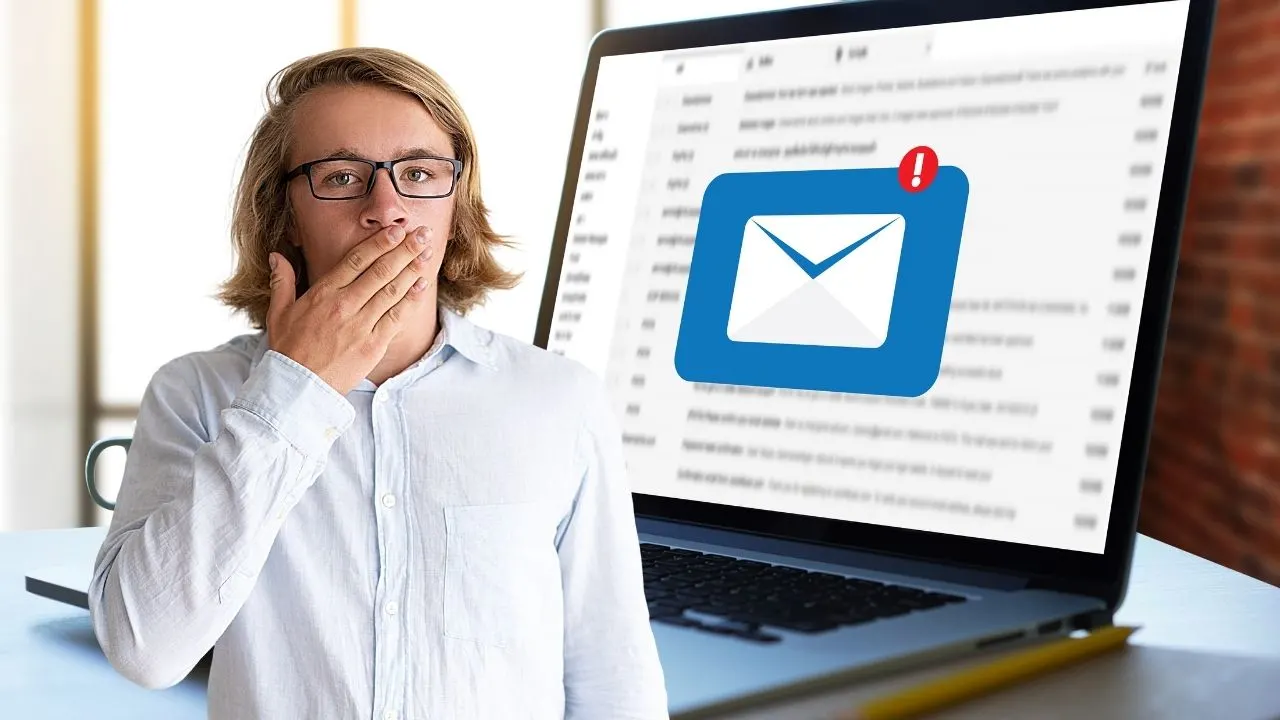
At the far end of the informality spectrum, the place where your closest friends live, you can just send a blank email with the attachment, and they will get it.
You see, we are all used to receiving important attachments via email, so it never comes as a surprise when we receive a blank email that is nothing more than a conduit for the “enclosed” attachment.
However, if you do want to write something in your email, you still don’t have to point out the fact that you’ve attached a file, especially if the other person is expecting you to send them said file.
Example:
Going to back to the example from above, the one where you were sending your friend the presentation for tomorrow, you could send them the following email:
Get some rest tonight because we need to be in tip-top shape tomorrow.”
Making it more formal
As is usually the case in business settings, you probably won’t be that familiar with the person you are emailing.
For instance, if you are sending your partner, supplier, or boss an email attachment, you won’t just send them a blank email, expecting them to know that the whole purpose of the email is to send an attachment.
So, for those occasions, here are a few phrases you can use:
4. I’ve attached …

When you tell someone to “see the attached …” or “find the attached …”, there is an underlying assumption that they were expecting this attachment at some point. For instance, when you are applying for a job, HR specialists expect to find your resume attached to the email.
So, when you put “please find my resume attached to this email,” it comes as a surprise to no one.
However, there are other occasions when the recipient of your email isn’t expecting an attachment of any kind.
In these circumstances, seeing an abrupt “please find attached…” can throw them for a loop.
Instead, should you choose to send someone an unexpected attachment, just let them know. Telling them that “I’ve attached (whatever)” acts as a signal that prepares them for the coming attachment.
That said, just because this phrase works when sending a surprise attachment doesn’t mean that you can’t use it when sending an expected attachment; it is perfectly fine to say “As per our conversation the other day, I’ve attached the company’s financial statements.”
Example:
Let’s say that you wanted to send a helpful article to one of your business partners. Here’s what you could say:
I’ve attached the article. Let me know what you think.”
5. I’m sharing (file/ document/ whatever you are actually sharing) with you
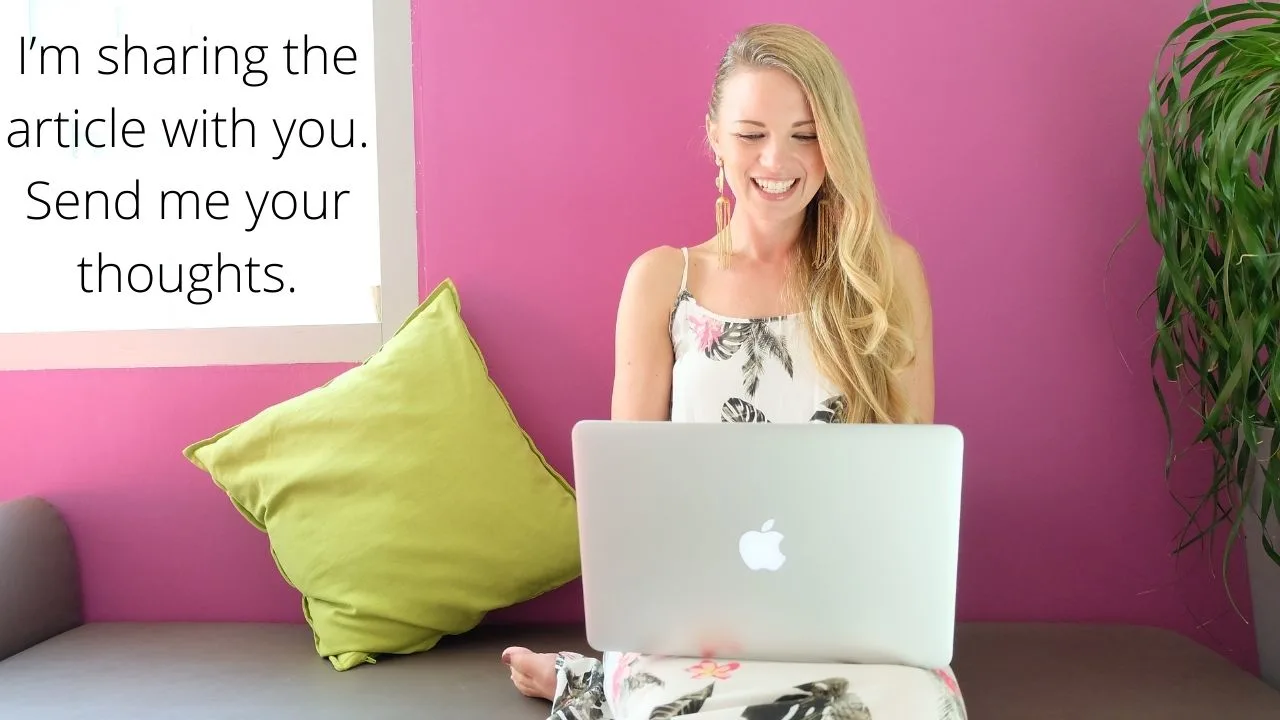
Similar to “I’ve attached …”, this phrase is direct and notifies the recipient of the fact that you’ve decided to share something with them.
However, it is more formal than “I’ve attached …”, making it more suitable for occasions where you want to exude a more professional aura.
Example:
In the above example, the one where you want to send a helpful article to one of your business partners, here is an alternative version of the same email:
So, I’m sharing the article with you. Send me your thoughts.”
6. You’ll find the (attachment) below

Rather than saying “please find the attachment”, you can say “you’ll find the attachment below.” It conveys the same exact meaning, but it’s just a little less stuffy.
Ergo, on the informal to formal spectrum, this phrase might lean a bit towards the formal end, yet it is still fine to be used with friends and acquaintances.
Example:
Let’s say that you are applying for a job. So, along with your email, you will attach your resume.
Here is what you could say:
You’ll find my resume attached below.
Please do not hesitate to get in touch with me should you have any more inquiries.
I look forward to your reply.”
Bringing out the professional in you
So far, we’ve seen how you can send attachments to your close acquaintances as well as your business partners and colleagues.
But, what about people with whom you have no familiarity whatsoever?
I’m talking about the president of your company, the mayor of your city, or the tax agent at the IRS. These are all people you may want to send attachments to, but you cannot treat them the same way you’d treat a partner.
So, when dealing with them, you want to keep things one hundred percent professional.
7. Please do not hesitate to contact me should you have any inquiries about the attachment
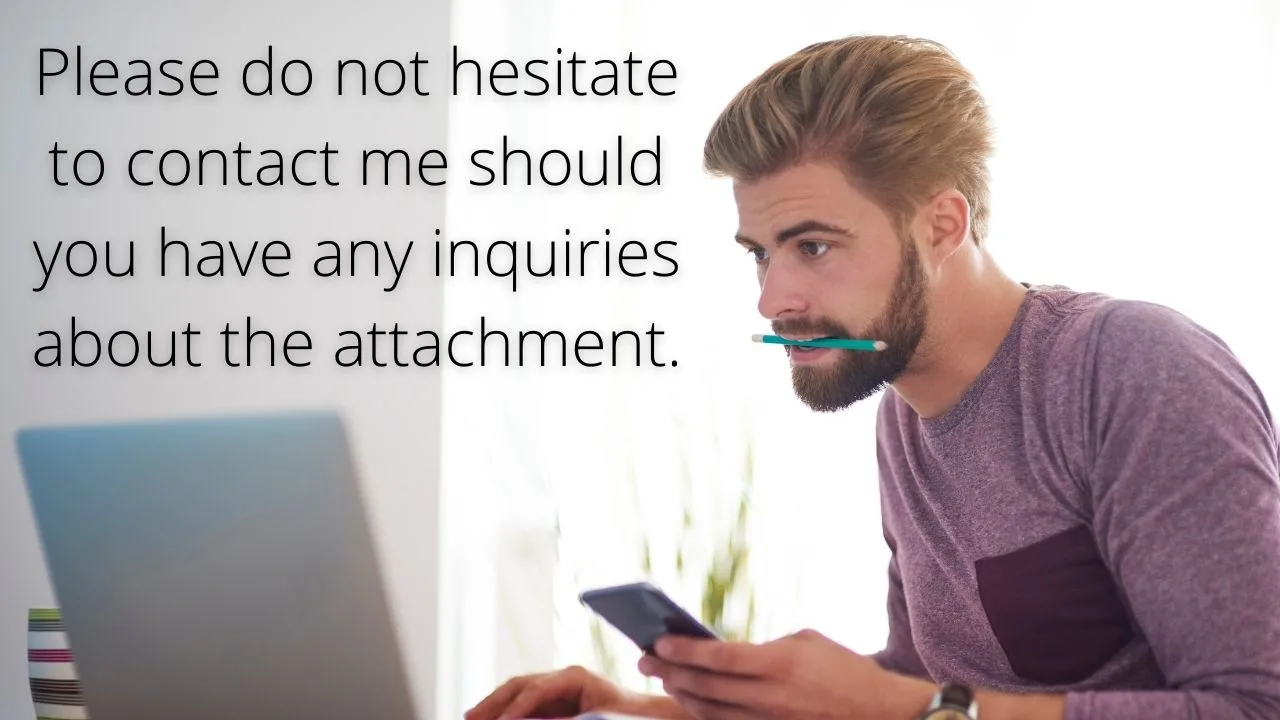
This phrase kills two birds with one stone: On the one hand, it notifies the recipient that there is an attachment with the email.
On the other hand, it lets the recipient know that you are available for questions should they have any.
Thanks to this one-two punch, this phrase works well with prospective clients as well as with anyone who might have follow-up questions about the attachment you’ve just sent them.
Example:
Let’s say that your company was applying to take part in a renovation project organized by your city. So, you send an email to the city mayor containing the following lines:
Please do not hesitate to contact us should you have any inquiries about the enclosed proposal.”
8. The requested document is attached to this email
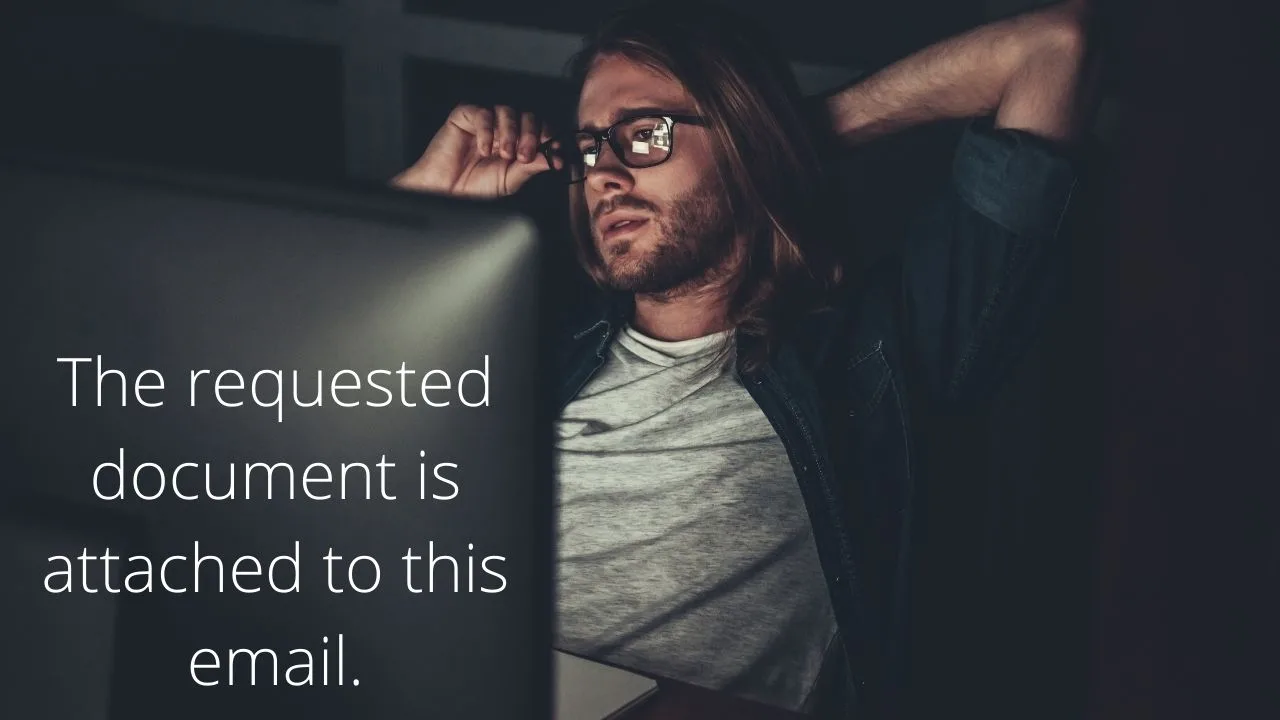
Obviously, this one only works if someone specifically asked you for a particular document; otherwise, you’ll just end up puzzling them.
That said, the phrase is concise and to-the-point. What’s more, by using the passive voice, it comes across as more professional; after all, the passive voice conveys objectivity and lack of emotional engagement, two things you want in a professional email.
Example:
Let’s say that the president of your company asked you to send him the proforma budget of your department for next year. Here is an excerpt of the email you could send him:
9. You will find (…) in the attached document/guide

Similar to a passive statement, this phrase comes across as professional partially because it removes any active agents, mainly the sender and recipient of the email.
Instead, the phrase keeps its eyes on the ball and talks about the “relevant information” being present within the attachment.
However, this is a tricky phrase to use. For instance, you can’t use it if someone specifically asked for the file you are sending them. In other words, it is best used when the focus of the email is the information itself, not the file.
This will probably make more sense when you see the below example.
Example:
Let’s say that you have been helping a client troubleshoot one of your products. So, this is an excerpt of the email you might send them:
The problem can be fixed by tuning the generator. Doing so is a relatively straightforward process.
You will find how you can tune the generator in the attached guide on maintaining generators. The information you are looking for will be on page 34.
If you have any more inquiries or would like further assistance, please do not hesitate to get in touch with us.”
As you might have noticed, the purpose of the attachment wasn’t to send the entire guide on maintaining generators; rather, the purpose was the specific information on how the client could tune their generator, which was on page 34 of the guide.
10. Please see attached file
“Please see attached file” may be considered a bit problematic by some. From the formal language perspective, this one lacks the determiner “the.”
With the hundreds of emails people read and write daily, business shorthands have also become all too common.
This is what happened with “Please see attached file,” a business email stock phrase that people would barely cringe at.
At times, you might even just receive an email message with nothing else inside except for “Please see attached file” plus the referred file itself.
When you use this expression in your email, it is expected that you have regular exchanges with your message receiver because of the toned-down writing style.
For clarity’s sake, this is how you can use this expression:
Example:
Dear John,
Thank you for your email yesterday. I’ve only read it this morning, and I apologize for the delayed response. I have converted the document according to your request.
Please see attached file. Let me know if it doesn’t work.
Kind regards,
Anne
11. Please see the attached file
“Please see the attached file” is simply more of the grammatically precise version of “Please see attached file.”
If you are concerned that your reader may think that you are leaning more toward “lazy writing,” then you should choose this version instead.
For instance, you could choose this when interacting with a first-time customer or client. You may also want to use this when emailing school authorities.
This one works well as an isolated statement, and it usually goes at the end of your email like in the following example:
Example:
Dear Dr. Rosenberg,
Thank you for your prompt response. It is a great honor to have you as one of my thesis committee. I have written a summary of my research plan, including a few possible SOPs for your review and reference.
Please see the attached file.
Kind regards,
Alison Watts
12. Please see attached file for your reference
Except for the missing determiner, this one is another grammatically complete expression that would make your writing look more well-thought.
In general, writing sentences that look grammatically complete suggests tact or courtesy toward your message receiver.
When you do this, the other person will also be prompted to use the same kind of language style in return. This is great for building business relationships.
Adding “for your reference” at the end suggests that whatever file you are sending will be used by the other person as a source of information.
Example:
Dear Ms. Daureen,
Thank you for your request. I have been out of the office for two days, which is why I’m only responding now. The report you have requested is not available in our database yet, but I am uploading it within the day. So, I’m sending you a raw copy instead.
Please see attached file for your reference.
Best regards,
Laura
13. Kindly see attached file
“Kindly see attached file” is another common business email shorthand like “Please see attached file” earlier.
Connotation-wise, “kindly” may sound a bit more polite than the usual “please.” This means that using this phrase makes your email more tactful.
Likewise, you may choose to add the determiner “the” before “attached” if you want to use a slightly more uptight language style.
Example:
Dear Dave,I am pleased to let you know that your graduation photo is now available.
Kindly see attached file.
Regards,
Donna
14. Attached herewith
If you are in the legal industry, “Attached herewith” may come off as a common phrase, and nobody may find this unusual.
The adverb “herewith” means “with this letter,” which clearly is a remnant of traditional language use. Since we use emails today, this usage may be inappropriate.
Also, some may argue that using “attached” and “herewith” together is redundant and has to be avoided.
Nevertheless, legal writing hasn’t evolved as much as other contexts have for a good reason, which is to leave little to no room for contradictions.
You may use “Attached herewith” either at the beginning of the sentence or at the end.
Example 1:
Dear Atty. Philip,
Attached herewith is the amended loan agreement between ABC, Inc., and HLC National Bank.
Please let me know soon if you can’t open the file.
Kind regards,
Mark
Example 2:
Dear Michael Flanders, Esq.,The revised swap confirmation agreement is attached herewith. Kindly let me know if further changes are necessary.
Sincerely,
Dory
15. Please see attached documents
If you are sending multiple files, “Please see attached documents” works well. This one particularly lets your reader know that more than one file is expected.
When your signpost message matches your attachments, your reader will be guided accordingly, leading to smoother transactions in the process.
Alternatively, you may also insert the determiner “the” before “attached” if you want a more flawless writing tone.
Here’s how you could use this one:
Example:
Dear Jason,
Thank you for reaching out to me. Your request for our local news headlines from August to October last year has been successfully processed
Glad to help you with your research.
Please see attached documents.
Kind regards,
Justine
16. Please check the attached file
In case you are unsure whether the attachment is correct, and you want your email receiver to confirm it, “Please check the attached file” could be your best pick.
By and large, though, you may also just use this expression as a convenient replacement for “Please see attached.”
In a best-case scenario, here’s how you might want to specifically use “Please check the attached file”:
Example:
Dear Ally,
Thank you for your instructions. I managed to log in to your PC earlier without any problem.
Please check the attached file. Hope I got the right one.
Regards,
Chris
17. I have attached the document to this email
If someone is asking for a particular document, this one works with utmost accuracy. Polite and grammatically complete, you can never go wrong with this.
Just make sure to double-check your attachment before hitting send, or else, your message receiver will end up scratching their head and sending your another return email.
Also note that this statement works in contexts where you would need to carefully apply the formal language.
Example:
Dear Christine,
This is just to inform you that I have retrieved the manuscript you are looking for. I have attached the document to this email.
Please let me know if you have any questions.
Kind regards,
Rue
18. Please find the attached file as per your request
“Please find the attached as per your request” is something you would use after successfully processing something and sending the information back to the request sender.
Although some may cringe at the redundant use of “as per,” we cannot deny the fact that this has also become a business stock phrase.
In fact, some of the most common usages of “as per” in the business world include “as per our conversation” and “as per your last email.”
Feel free to use the above alternative in the manner below:
Example:
Dear Miss Sanchez,
We are pleased to inform you that your old manuscript has been successfully retrieved from our older database. Please find the attached file as per your request.
Thank you for your patience.
Sincerely yours,
Kaia
19. In the attachment, you will find…
To guide your reader even more effectively, you may want to shortly describe your attachment. This way, your message receiver knows what exactly to expect.
You may also want to add further instructions on how to open the file as well as prompt the person to let you know in case something won’t work.
This one works well when communicating with the person for the first time or getting back to him or her after a while.
Here’s how the expression plays out in a business email:
Example:
Dear Darryl,
I apologize for getting back to you a bit late. I have been out of the office for a few days and only came back today. I hope it’s not too late to send you your request.
In the attachment, you will find a folder titled “Conference 2023.” It is in ZIP file format, so you may have to download everything first.
Please let me know if you are able to access all documents inside.
Kind regards,
Coleen
Bonus formal alternative expressions to “Please find attached”
I have attached the requested file below
The message “I have attached the requested file below” works in a particular context that requires the use of formal language.
Formal language choice is exemplified by the grammatical completeness of the statement as well as the avoidance of contractions.
Additionally, this particular message works specifically if the attachment has been indeed requested by the other person.
Also, this prompt must only be used when the attachment is visually located somewhere below the prompt because of the spatial denotation of the adverb “below.”
You may also either use appropriate punctuation marks like the colon or period after the last word of the message, as in the example below:
Example:
Thank you for your reminder.
I have attached the requested file below:
[the file]
Regards,
Valerie
Attached here is the file requested
Another option to use is “attached here is the file requested,” which also makes use of a word with spatial denotation.
The adverb “here” is always relative to the context of the conversation, particularly from the speaker or writer’s perspective.
So, when you see this message in an email, “here” automatically refers to the virtual space where the electronic mail belongs.
You may also end this prompt with either a period or a colon, just like in the next example:
Example:
Thank you for reminding me about the product quote, and I apologize for the delay.
Attached here is the file requested:
[file]
Sincerely,
Patrick
Attached below is the requested file
“Attached below is the requested file” is simply the passive version of “I have attached the requested file below.”
Sentence passivization works when the agent is unknown, irrelevant, or already implied in the context of the conversation.
In this prompt, you are doing away with the usage of “I” which is already implied and, therefore, irrelevant.
As you may figure, this type of sentence construction is a practical choice especially when your job involves frequent and numerous email exchanges because it shortens your sentences.
Here’s how you might use “Attached below is the requested file” in context:
Example:
I am pleased to approve your request for an electronic copy of your COE.
Attached below is the requested file:
[file]
Sincerely,
Zoey Hernandez
HR Associate

Hey fellow Linguaholics! It’s me, Marcel. I am the proud owner of linguaholic.com. Languages have always been my passion and I have studied Linguistics, Computational Linguistics and Sinology at the University of Zurich. It is my utmost pleasure to share with all of you guys what I know about languages and linguistics in general.

